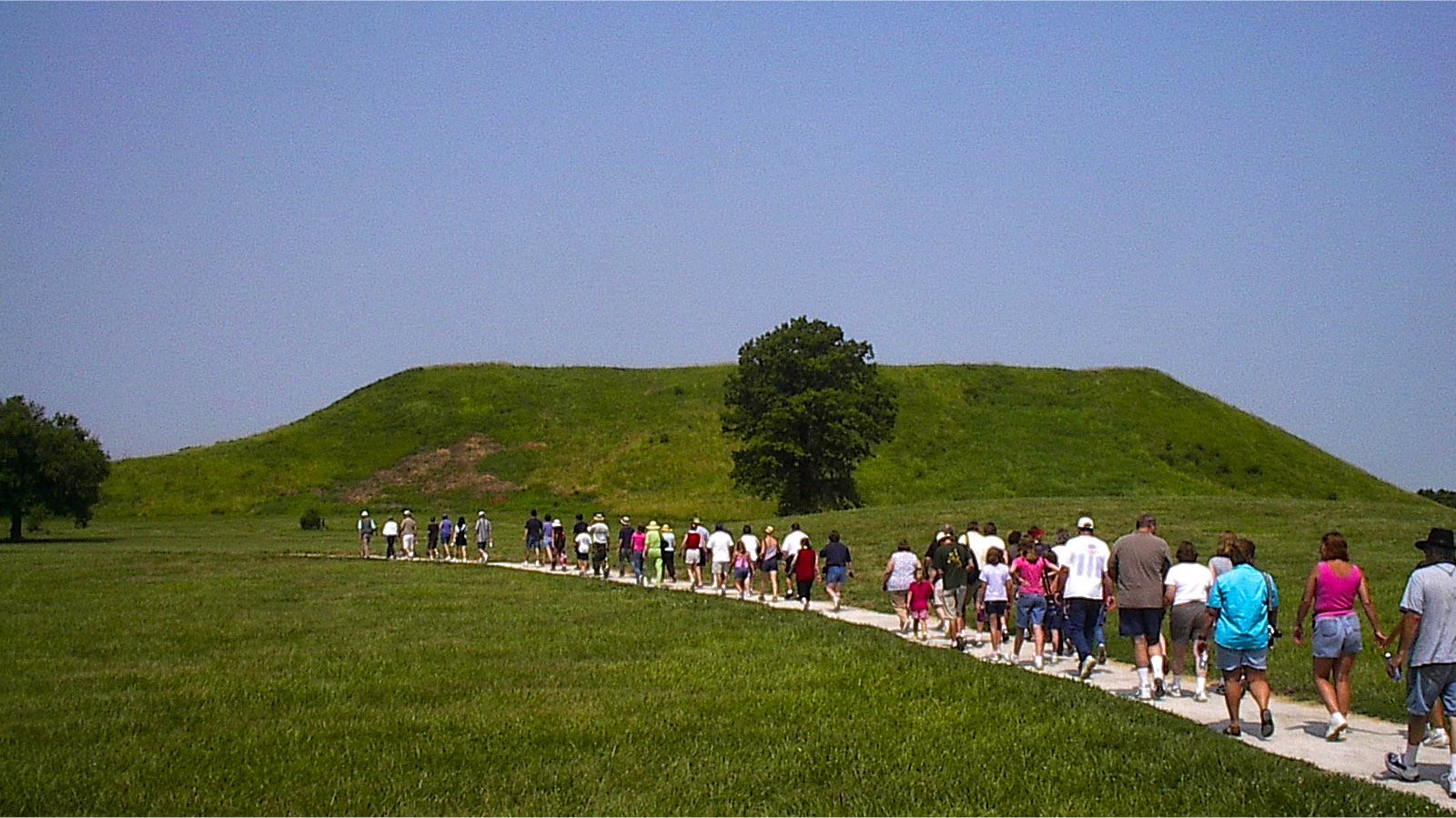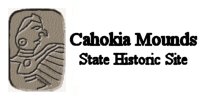130 Ramey Street, (off Collinsville Road)
Collinsville, Illinois
618-346-5160
Monks Mound - the largest at Cahokia
Pre-Columbian life exhibit in the Interpretative Center
Located at Cahokia Mounds are the remains of the most sophisticated Native American Civilization north of Mexico. Managed by the Illinois Historic Preservation Agency, this 2,200 acre site has been designated a World Heritage Site by the United Nations Educational, Scientific, and Cultural Organization for its importance in understanding the cultural heritage of the native civilizations in North America.
What is known about the inhabitants of Cahokia Mounds comes from archeological finds, as what became of them is unknown. The site is named for a subtribe of the Illini - the Cahokia - who lived in the region when the French arrived in the late 1600's and archeologists refer to the inhabitants as the Cahokians. Native Americans of the Late Woodland Culture first inhabited the area from 700 C.E. Between 800 C.E. and 1000 another culture emerged, called Mississippian by archeologists. This culture developed an agriculture system that provided a stable food base enabling a complex social, political, and religious community to emerge. After 1000 C.E., Cahokia became a regional center for this culture with many satellite communities in the region, including St. Louis, which once was referred to as "Mound City" before the mounds were leveled to make way for city projects.
The prominent features of Cahokia are its mounds. Originally there were over 120 mounds, but the location of only 109 have been recorded and about 68 are preserved on the site. The mounds are entirely made of earth transported on people’s backs in baskets from nearby borrow pits to the mound construction sites. It is estimated that over 50 million cubic feet was moved by the Cahokians for mound construction in this manner. Three types of mounds were constructed: platform, conical, and ridgetop. The most common type of mound found at Cahokia is the platform mound. The level top of this type of mound was used to for ceremonial buildings and homes of the elite. It is theorized that the conical and ridgetop mounds were used for burial purposes and landmarks.
Monk's Mound was the centerpiece of Cahokia. This platform mound is the largest Native American structure north of Mexico and the largest prehistoric earthen construction in the New World. Constructed in several stages between 900 and 1200 C.E. Monk's Mound contains over 22 million square feet of earth. Monk’s Mound consists of four terraces, the top being the site where the Cahokian ruler lived, conducted religious ceremonies, and governed the city. The name derives from the French Trappist Monks who lived in the area in the early 1800's. Two other features of the site are the stockade and Woodhenge. The stockade was a 2-mile wall around the city center by placing upright posts in a trench. It may have served a defensive purpose, although there is no evidence the Cahokians had any enemies, or to segregate the elite section of town. Woodhenge is a reconstruction of one of the solar calendar sites used by the Cahokians.
The Interpretative Center at the site includes a museum, information desk, café and a gift shop. The museum has an impressive number of displays that show the various aspects of Cahokian life. In the center is "The Mirrored Box (photo right)," a walk through life size diorama depicting day to day activities of Cahokia in the year 1200 C.E. Exhibit islands are placed throughout the museum, each with an introductory panel that tells the Cahokian story from the point of view of both the scientist and the prehistoric citizen. Colorful wall murals depict Cahokia at its peak in 1150 C.E. An orientation show, the 15 minute award winning "City of the Sun," is shown hourly from 10 am to 4 pm. Guidebooks and tapes for several self guided tours are available in many languages at the Information Desk. The Museum Shop has a large selection of Native American art, jewelry, books and tapes.
The Lewis and Clark Connection
“I discovered an Indian Fortification, … this fortress is 9 mouns forming a … about this place I found great quantities of Earthen ware & flints – about ½ m N. is a Grave of an Emenince ...” This journal entry reports on a hunting expedition on January 9, 1804 when Clark came across the northwest edge of the Cahokia Mounds, at present Mitchell, Madison County, Illinois. The mounds that Clark found have been obliterated.
Visit our special Lewis and Clark Section to learn more about the Corps of Discovery’s experience during their stay in the Middle Mississippi River Valley. greatriverroad.com’s special coverage includes information on all of the region’s sites and events as well as supplemental articles relating to the expedition’s experience during the winter of 1803-04.
Visiting Cahokia Mounds State Historic Site
Visiting Hours
Interpretive Center:
Thursday - Sunday: 9 am - 5 pm
Grounds:
Open daily: 8 am - dusk
Closed on Major Holidays
There is no charge to visit Cahokia Mounds State Historic Site, although donations are suggested.
Cahokia Mounds State Historic Sites - official site of Cahokia Mounds
Explore the community of Collinsville.

















